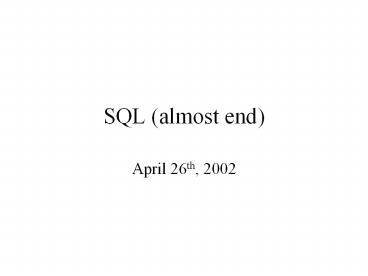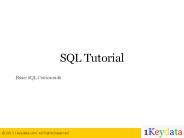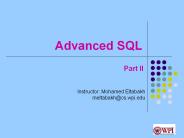SQL (almost end) - PowerPoint PPT Presentation
Title:
SQL (almost end)
Description:
Title: Database Design Author: dan Last modified by: uw Created Date: 1/5/1998 10:52:07 AM Document presentation format: On-screen Show Company: uw Other titles – PowerPoint PPT presentation
Number of Views:50
Avg rating:3.0/5.0
Title: SQL (almost end)
1
SQL (almost end)
- April 26th, 2002
2
Agenda
- HAVING clause
- Views
- Modifying views
- Reusing views
3
HAVING Clause
Same query, except that we consider only
products that had at least 100 buyers.
SELECT product, Sum(price quantity) FROM
Purchase WHERE date gt 9/1 GROUP
BY product HAVING Sum(quantity) gt 30
HAVING clause contains conditions on aggregates.
4
General form of Grouping and Aggregation
- SELECT S
- FROM R1,,Rn
- WHERE C1
- GROUP BY a1,,ak
- HAVING C2
- S may contain attributes a1,,ak and/or any
aggregates but NO OTHER ATTRIBUTES - C1 is any condition on the attributes in
R1,,Rn - C2 is any condition on aggregate expressions
5
General form of Grouping and Aggregation
- SELECT S
- FROM R1,,Rn
- WHERE C1
- GROUP BY a1,,ak
- HAVING C2
- Evaluation steps
- Compute the FROM-WHERE part, obtain a table with
all attributes in R1,,Rn - Group by the attributes a1,,ak
- Compute the aggregates in C2 and keep only groups
satisfying C2 - Compute aggregates in S and return the result
6
Aggregation
- Author(login,name)
- Document(url, title)
- Wrote(login,url)
- Mentions(url,word)
7
- Find all authors who wrote at least 10 documents
Select author.name From author, wrote Where
author.loginwrote.login Groupby
author.name Having count(wrote.url) gt 10
8
- Find all authors who have a vocabulary over 10000
Select author.name From author, wrote,
mentions Where author.loginwrote.login and
wrote.urlmentions.url Groupby author.name Having
count(distinct mentions.word) gt 10000
9
Views
10
Defining Views
Views are relations, except that they are not
physically stored. For presenting different
information to different users Employee(ssn,
name, department, project, salary) Payroll
has access to Employee, others only to Developers
CREATE VIEW Developers AS SELECT name,
project FROM Employee WHERE department
Development
11
A Different View
Person(name, city) Purchase(buyer, seller,
product, store) Product(name, maker,
category) We have a new virtual
table Seattle-view(buyer, seller, product, store)
CREATE VIEW Seattle-view AS SELECT
buyer, seller, product, store FROM
Person, Purchase WHERE Person.city
Seattle AND
Person.name Purchase.buyer
12
A Different View
We can later use the view
SELECT name, store FROM Seattle-view,
Product WHERE Seattle-view.product
Product.name AND
Product.category shoes
13
What Happens When We Query a View ?
- SELECT name, Seattle-view.store
- FROM Seattle-view, Product
- WHERE Seattle-view.product Product.name AND
- Product.category shoes
SELECT name, Purchase.store FROM Person,
Purchase, Product WHERE Person.city Seattle
AND Person.name
Purchase.buyer AND
Purchase.poduct Product.name AND
Product.category shoes
14
Types of Views
- Virtual views
- Used in databases
- Computed only on-demand slow at runtime
- Always up to date
- Materialized views
- Used in data warehouses (but recently also in
DBMS) - Precomputed offline fast at runtime
- May have stale data
15
Updating Views
How can I insert a tuple into a table that
doesnt exist? Employee(ssn, name, department,
project, salary)
CREATE VIEW Developers AS SELECT name,
project FROM Employee WHERE department
Development
If we make the following insertion
INSERT INTO Developers VALUES(Joe,
Optimizer)
INSERT INTO Employee VALUES(NULL, Joe, NULL,
Optimizer, NULL)
It becomes
16
Non-Updatable Views
CREATE VIEW Seattle-view AS SELECT
seller, product, store FROM Person,
Purchase WHERE Person.city Seattle
AND Person.name
Purchase.buyer
How can we add the following tuple to the view?
(Joe, Shoe Model 12345, Nine
West) We need to add Joe to Person first.
One copy ? More copies ?
17
Answering Queries Using Views
- What if we want to use a set of views to answer a
query. - Why?
- The obvious reason
- Answering queries over web data sources.
- Very cool stuff! (i.e., I did a lot of research
on this).
18
Reusing a Materialized View
- Suppose I have only the result of SeattleView
- SELECT buyer, seller, product, store
- FROM Person, Purchase
- WHERE Person.city Seattle AND
- Person.per-name
Purchase.buyer - and I want to answer the query
- SELECT buyer, seller
- FROM Person, Purchase
- WHERE Person.city Seattle AND
- Person.per-name
Purchase.buyer AND - Purchase.productgizmo
. - Then, I can rewrite the query using the view.
19
Query Rewriting Using Views
- Rewritten query
- SELECT buyer, seller
- FROM SeattleView
- WHERE product gizmo
- Original query
- SELECT buyer, seller
- FROM Person, Purchase
- WHERE Person.city Seattle AND
- Person.per-name
Purchase.buyer AND - Purchase.productgizmo
.
20
Another Example
- I still have only the result of SeattleView
- SELECT buyer, seller, product, store
- FROM Person, Purchase
- WHERE Person.city Seattle AND
- Person.per-name
Purchase.buyer - but I want to answer the query
- SELECT buyer, seller
- FROM Person, Purchase
- WHERE Person.city Seattle AND
- Person.per-name
Purchase.buyer AND - Person.Phone LIKE 206
543 .
21
And Now?
- I still have only the result of SeattleView
- SELECT buyer, seller, product, store
- FROM Person, Purchase, Product
- WHERE Person.city Seattle AND
- Person.per-name
Purchase.buyer AND - Purchase.product
Product.name - but I want to answer the query
- SELECT buyer, seller
- FROM Person, Purchase
- WHERE Person.city Seattle AND
- Person.per-name
Purchase.buyer.
22
And Now?
- I still have only the result of
- SELECT seller, buyer, Sum(Price)
- FROM Purchase
- WHERE Purchase.store The Bon
- Group By seller, buyer
- but I want to answer the query
- SELECT seller, Sum(Price)
- FROM Purchase
- WHERE Person.store The Bon
- Group By seller
- And what if its the other way around?
23
Finally
- I still have only the result of
- SELECT seller, buyer, Count()
- FROM Purchase
- WHERE Purchase.store The Bon
- Group By seller, buyer
- but I want to answer the query
- SELECT seller, Count()
- FROM Purchase
- WHERE Person.store The Bon
- Group By seller
24
The General Problem
- Given a set of views V1,,Vn, and a query Q, can
we answer Q using only the answers to V1,,Vn? - Why do we care?
- We can answer queries more efficiently.
- We can query data sources on the WWW in a
principled manner. - Many, many papers on this problem.
- The best performing algorithm The MiniCon
Algorithm, (Pottinger (Ha)Levy, 2000).
25
Querying the WWW
- Assume a virtual schema of the WWW, e.g.,
- Course(number, university, title, prof, quarter)
- Every data source on the web contains the answer
to a view over the virtual schema - UW database SELECT number, title, prof
- FROM Course
- WHERE univUW AND
quarter2/02 - Stanford database SELECT number, title, prof,
quarter - FROM Course
- WHERE
univStanford - User query find all professors who teach
database systems































